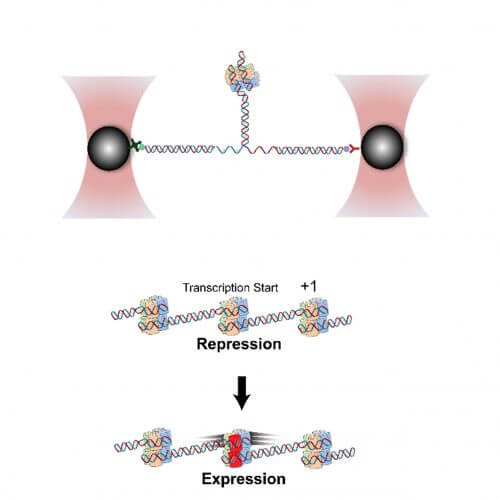The complexity and dynamics of chromatin structure pose a great challenge for scientists interested in studying how it controls gene expression. This is where an innovative research tool in the field of life sciences comes into play: the optical forceps. This technology makes it possible to use laser beams to exert mechanical forces on individual molecules.

Research conducted at the Faculty of Biology at the Technion sheds light on the dynamics of the chromatin molecule - the complex containing DNA and the proteins associated with it - and its role in controlling genetic expression. The research, published in the journal Nature Communications, was conducted by PhD student Sergey Rudnitsky under the guidance of professors Ariel Kaplan and Filipa Melamed.
The hereditary information encoded in DNA determines how the organism will develop and affects the course of its life in health and disease. However, DNA does not exist in an organism as an isolated unit; It forms a complex structure together with the histones - proteins with a positive charge, around which the DNA is wrapped as a kind of helix. This complex structure, the nucleosome, is the basic building block that makes up the chromatin.
The packaging of the DNA in the nucleosome protects the DNA from various hazards and creates "spatial savings", as it reduces the size of the DNA molecule 10,000 times. However, the same compactness that developed during evolution has a price: it reduces the accessibility of DNA to the systems required to read the "operating instructions" encoded in it. This is why chromatin, and the way it packages different regions of the DNA, has a huge impact on the degree of genetic expression of each gene in the DNA.
The complexity and dynamics of chromatin structure pose a great challenge for scientists interested in studying how it controls gene expression. This is where an innovative research tool in the field of life sciences comes into play: the optical forceps. This technology makes it possible to use laser beams to exert mechanical forces on individual molecules.
"The effect of chromatin structure on gene expression has been studied for many years using different methods," explains Prof. Kaplan, "but in most cases it is studied as a 'cluster of molecules' and not at the level of the single molecule. Now, using the optical tweezers technology, we are able to 'cleave' a single chromatin molecule and study its properties and its role in the control of genetic expression."
The researchers, who focused on a histone called H2A.Z, discovered that nucleosomes containing it are characterized by low stability and high mobility on the DNA molecule. The same dynamism, it turns out, plays an important role in the control of genetic expression and is a control mechanism that was not known until now. "In fact, the nucleosomes close to the end of the gene are the first line of expression control, and understanding them sheds light on how genes are controlled in different cells and in different situations. In this study we investigated the histone H2A.Z in relation to two genes related to the reproductive system, therefore the results of the study contribute to the understanding of fertility mechanisms; However, the implications of the research are much broader due to the importance of the control of genetic expression in developmental processes and the development of various diseases."
